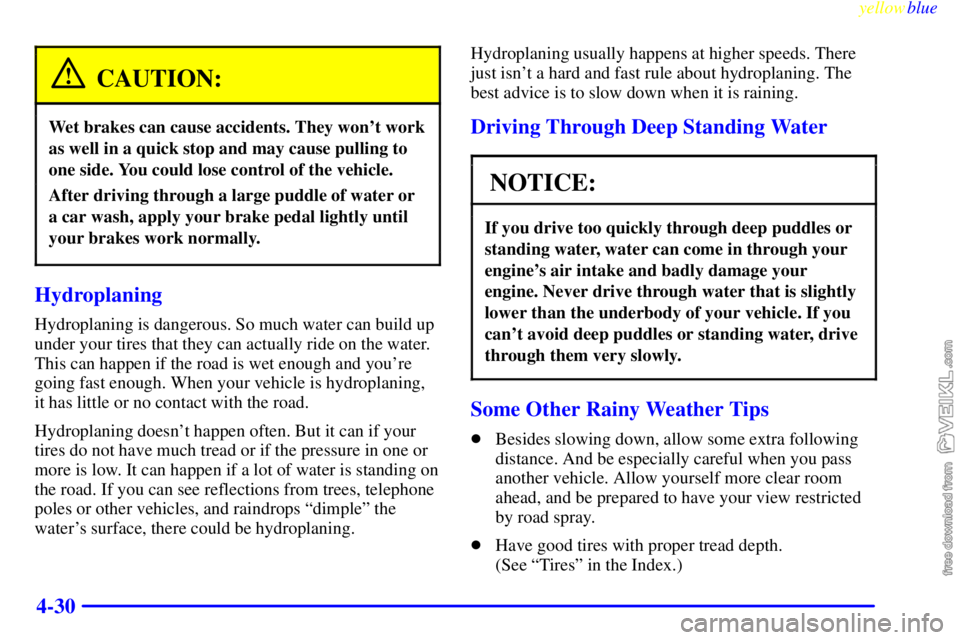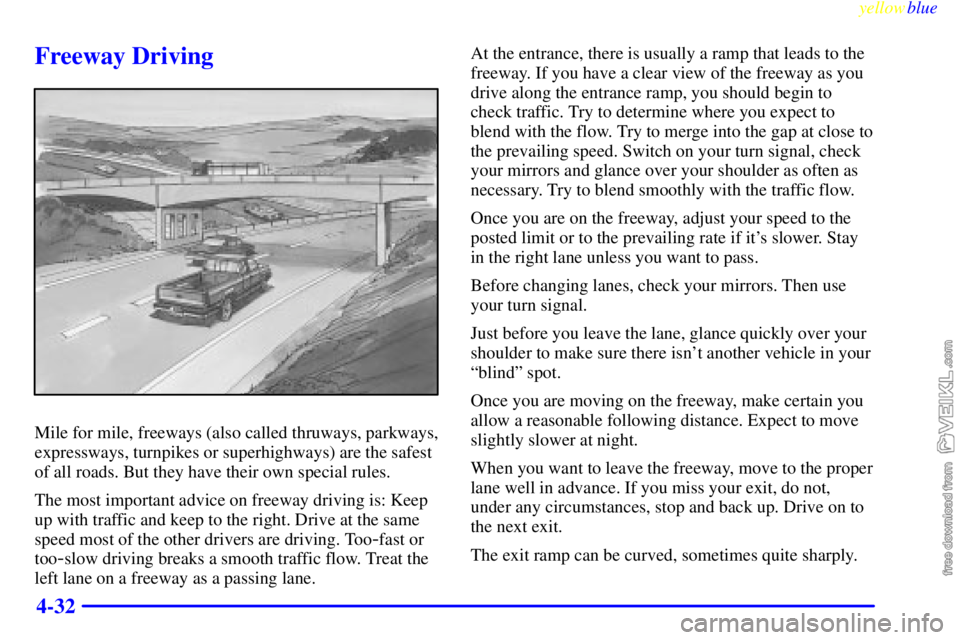Page 212 of 440

yellowblue
4-30
CAUTION:
Wet brakes can cause accidents. They won't work
as well in a quick stop and may cause pulling to
one side. You could lose control of the vehicle.
After driving through a large puddle of water or
a car wash, apply your brake pedal lightly until
your brakes work normally.
Hydroplaning
Hydroplaning is dangerous. So much water can build up
under your tires that they can actually ride on the water.
This can happen if the road is wet enough and you're
going fast enough. When your vehicle is hydroplaning,
it has little or no contact with the road.
Hydroplaning doesn't happen often. But it can if your
tires do not have much tread or if the pressure in one or
more is low. It can happen if a lot of water is standing on
the road. If you can see reflections from trees, telephone
poles or other vehicles, and raindrops ªdimpleº the
water's surface, there could be hydroplaning.Hydroplaning usually happens at higher speeds. There
just isn't a hard and fast rule about hydroplaning. The
best advice is to slow down when it is raining.
Driving Through Deep Standing Water
NOTICE:
If you drive too quickly through deep puddles or
standing water, water can come in through your
engine's air intake and badly damage your
engine. Never drive through water that is slightly
lower than the underbody of your vehicle. If you
can't avoid deep puddles or standing water, drive
through them very slowly.
Some Other Rainy Weather Tips
�Besides slowing down, allow some extra following
distance. And be especially careful when you pass
another vehicle. Allow yourself more clear room
ahead, and be prepared to have your view restricted
by road spray.
�Have good tires with proper tread depth.
(See ªTiresº in the Index.)
Page 213 of 440
yellowblue
4-31
City Driving
One of the biggest problems with city streets is the
amount of traffic on them. You'll want to watch out for
what the other drivers are doing and pay attention to
traffic signals.Here are ways to increase your safety in city driving:
�Know the best way to get to where you are going.
Get a city map and plan your trip into an
unknown part of the city just as you would for
a cross
-country trip.
�Try to use the freeways that rim and crisscross
most large cities. You'll save time and energy.
(See the next part, ªFreeway Driving.º)
�Treat a green light as a warning signal. A traffic light
is there because the corner is busy enough to need it.
When a light turns green, and just before you start
to move, check both ways for vehicles that have
not cleared the intersection or may be running
the red light.
Page 214 of 440

yellowblue
4-32
Freeway Driving
Mile for mile, freeways (also called thruways, parkways,
expressways, turnpikes or superhighways) are the safest
of all roads. But they have their own special rules.
The most important advice on freeway driving is: Keep
up with traffic and keep to the right. Drive at the same
speed most of the other drivers are driving. Too
-fast or
too
-slow driving breaks a smooth traffic flow. Treat the
left lane on a freeway as a passing lane.At the entrance, there is usually a ramp that leads to the
freeway. If you have a clear view of the freeway as you
drive along the entrance ramp, you should begin to
check traffic. Try to determine where you expect to
blend with the flow. Try to merge into the gap at close to
the prevailing speed. Switch on your turn signal, check
your mirrors and glance over your shoulder as often as
necessary. Try to blend smoothly with the traffic flow.
Once you are on the freeway, adjust your speed to the
posted limit or to the prevailing rate if it's slower. Stay
in the right lane unless you want to pass.
Before changing lanes, check your mirrors. Then use
your turn signal.
Just before you leave the lane, glance quickly over your
shoulder to make sure there isn't another vehicle in your
ªblindº spot.
Once you are moving on the freeway, make certain you
allow a reasonable following distance. Expect to move
slightly slower at night.
When you want to leave the freeway, move to the proper
lane well in advance. If you miss your exit, do not,
under any circumstances, stop and back up. Drive on to
the next exit.
The exit ramp can be curved, sometimes quite sharply.
Page 218 of 440
yellowblue
4-36
Winter DrivingHere are some tips for winter driving:
�Have your vehicle in good shape for winter.
�You may want to put winter emergency supplies in
your vehicle.
Include an ice scraper, a small brush or broom, a supply
of windshield washer fluid, a rag, some winter outer
clothing, a small shovel, a flashlight, a red cloth and
reflective warning triangles. And, if you will be driving
under severe conditions, include a small bag of sand, a
piece of old carpet or a couple of burlap bags to help
provide traction. Be sure you properly secure these
items in your vehicle.
Page 222 of 440

yellowblue
4-40
CAUTION:
Snow can trap exhaust gases under your vehicle.
This can cause deadly CO (carbon monoxide) gas
to get inside. CO could overcome you and kill
you. You can't see it or smell it, so you might not
know it is in your vehicle. Clear away snow from
around the base of your vehicle, especially any
that is blocking your exhaust pipe. And check
around again from time to time to be sure snow
doesn't collect there.
Open a window just a little on the side of the
vehicle that's away from the wind. This will help
keep CO out.
Run your engine only as long as you must. This saves
fuel. When you run the engine, make it go a little faster
than just idle. That is, push the accelerator slightly. This
uses less fuel for the heat that you get and it keeps the
battery (or batteries) charged. You will need a
well
-charged battery (or batteries) to restart the vehicle,
and possibly for signaling later on with your headlamps.
Let the heater run for a while.
If you have a diesel engine, you may have to run it at a
higher speed to get enough heat. Then, shut the engine
off and close the window almost all the way to preserve
the heat. Start the engine again and repeat this only
when you feel really uncomfortable from the cold. But
do it as little as possible. Preserve the fuel as long as you
can. To help keep warm, you can get out of the vehicle
and do some fairly vigorous exercises every half hour or
so until help comes.
Page 230 of 440

yellowblue
4-48
Camper Wiring Harness
(If Equipped)
A five-wire harness may be stored under your vehicle.
The harness is located inside the frame rail and is even
with the front of the pickup box. This harness has a
30 amp battery feed wire and no connector, and should be
wired by a qualified electrical technician. After choosing
an aftermarket mating connector pair, have the technician
attach one connector to the five
-wire camper harness and
the other connector to the wiring harness for the camper.
The technician can use the following color code chart
when connecting the wiring harness to your camper.�Brown: Rear Lamps
�Yellow: Left Stoplamp and Turn Signal
�Dark Green: Right Stoplamp and Turn Signal
�White (Heavy Gage): Ground
�Light Green: Back
-up Lamps
When the harness is not being used, store it in its
original place. Wrap the harness together and tie it
neatly so it won't be damaged.
Pickup Conversion to Chassis Cab
General Motors is aware that some vehicle owners may
consider having the pickup box removed and a
commercial or recreational body installed. Before you
do so, first contact the GM Customer Assistance Office
for your area for information on such conversions
specific to this vehicle. (See the ªWarranty and Owner
Assistanceº booklet for Customer Assistance Office.)
Owners should be aware that, as manufactured, there are
differences between a chassis cab and a pickup with the
box removed which may affect vehicle safety. The
components necessary to adapt a pickup to permit its
safe use with a specialized body should be installed by a
body builder in accordance with the information
available from the Customer Assistance Office.
Page 242 of 440

yellowblue
4-60 Trailer Wiring Harness
A. Light-Duty Wiring Harness
B. Additional Heavy
-Duty Wiring
C. Tie Straps
An eight
-wire harness is stored under the rear end of
your vehicle. Five wires (A) are located between the rear
bumper and the spare tire, near the center. This wiring
harness is tie
-strapped to the taillamp and stoplamp
harness. Three wires (B) (light gauge white, blue and
orange) are located at the rear left hand frame rail.This harness has a 30
-amp battery feed wire and no
connector, and should be wired by a qualified electrical
technician. After choosing an aftermarket mating
connector pair, have the technician attach one connector
to the eight
-wire trailer harness and the other connector
to the wiring harness on the trailer. Be sure that the
wiring harness on the trailer is strapped to the trailer's
frame and leave it loose enough so that the wiring
doesn't bend or break, but not so loose that it drags on
the ground. The technician can use the following color
code chart when connecting the wiring harness to
your trailer.
�Brown: Rear Lamps
�Yellow: Left Stoplamp and Turn Signal
�Dark Green: Right Stoplamp and Turn Signal
�White (Heavy Gauge): Ground
�Light Green: Back
-up Lamps
�White (Light Gauge): Center High
-Mounted
Stop Lamp
�Blue: Auxiliary/Electric Trailer Brake Circuit
�Orange: Fused Auxiliary Circuit
Store the harness in its original place. Wrap the harness
together and tie it neatly so it won't be damaged.
Page 249 of 440

yellowblue
5-3
Other Warning Devices
If you carry reflective triangles, you can use them to
warn others. Set one up at the side of the road about
300 feet (100 m) behind your vehicle.
Jump Starting
If your battery (or batteries) have run down, you may
want to use another vehicle and some jumper cables
to start your vehicle. But please use the following steps
to do it safely.
CAUTION:
Batteries can hurt you. They can be
dangerous because:
�They contain acid that can burn you.
�They contain gas that can explode or ignite.
�They contain enough electricity to
burn you.
If you don't follow these steps exactly, some or
all of these things can hurt you.
NOTICE:
Ignoring these steps could result in costly damage
to your vehicle that wouldn't be covered by
your warranty.
The ACDelco Freedom� battery in your vehicle
has a built
-in hydrometer. Do not charge, test or
jump start the battery if the hydrometer looks
clear or light yellow. Replace the battery when
there is a clear or light yellow hydrometer and a
cranking complaint.
Trying to start your vehicle by pushing or pulling
it won't work, and it could damage your vehicle.
1. Check the other vehicle. It must have a 12-volt
battery with a negative ground system.
NOTICE:
If the other system isn't a 12-volt system with a
negative ground, both vehicles can be damaged.